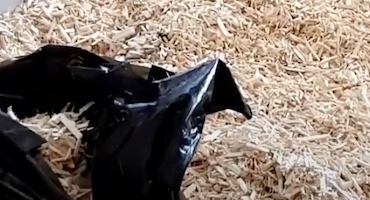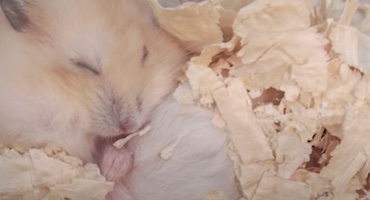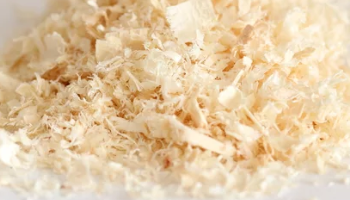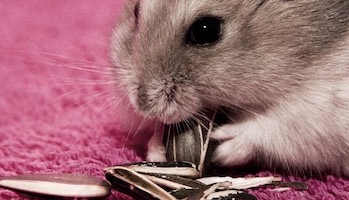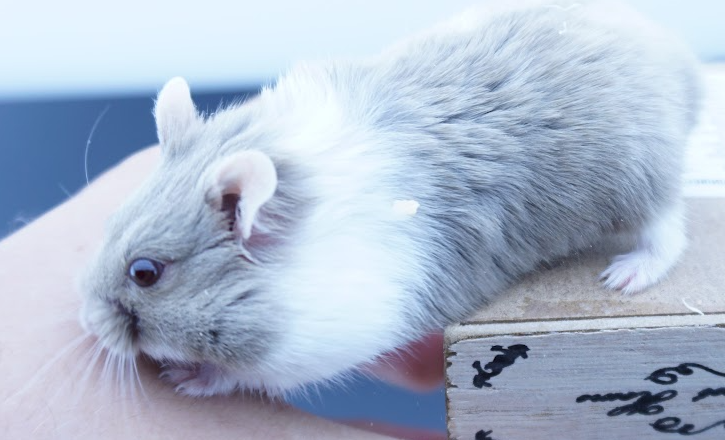The Syrian hamster goes by many names such as golden, teddy bear and fancy hamsters. These popular pets originally came from the northern part of Syria and southern Turkey. Believe it or not, they were called “vulnerable” there at the time. However, after a period of being used for studies, these small critters have become a loved household pet.
“Hamming” It Up
These small rodents are so cute sporting their most common golden-brown coat. This appearance is what gives them the nickname golden or teddy bear hamsters. Their little body is stout with a small tail hidden underneath their fur.
The face of the Syrian hamster has large eyes and petal-shaped ears. To store food as they chew, these rodents have small pouches that puff up as they eat.
The Syrian hamster comes in weighing between 5-7 ounces. That is about the same weight as five pieces of bread. This small rodent will grow to between 5-7 inches long, the perfect size to hold in your hand.
Syrian Hamster Behavior
Some people may describe these pets as “nippy.” However, if you tame your hamster and handle it correctly, they are great family pets.
Like most small rodent, Syrian hamsters can move very quickly. Syrian hamsters are very active. The more you can handle your new pet, the more friendly it will become.
Syrian Hamsters as Pets
Syrian hamsters have been called a “beginner” pet. They will make an excellent pet for your family, especially for children. These pets have a lifespan of 2-3 years, so the time commitment is relatively short.
It is essential that you commit the time to tame your hamster to make sure it can be handled without biting. Taming your hamster is not difficult if you follow a few simple steps.
Resist the desire to hold your hamster the first day you bring it home. Give the new pet a couple of days to adjust to its new surroundings.
Begin to talk to your hamster after a few days in a gentle voice. You can begin to reach your hand in the cage to change the water or replace the food. You want the hamster to get used to your hand and voice.
By now, the hamster will be familiar with your presence. Begin to put your hand in the cage until the hamster approaches and sniffs your hand. You can place a piece of seed in your palm and allow the hamster to crawl up on your hand.
If the hamster does nip your hand or finger, don’t panic! Slowly move your hand out of the cage and try again later. You want to be sure not to make sudden movements that will startle the hamster.
Once the new pet feels comfortable enough to approach your hand, gently raise it a few inches in the cage. It is okay if your new friend jumps off of your hand. Simply allow it to jump off and try again.
When the hamster allows you to raise your hand within the cage, you can now begin to pick it up. Start with a surface below you in case the new friend escapes your grasp. Gently cup the hamster in the palm of your hand.
This process may take several days or up to a month. Be patient and continue to try to bond with your new pet. The more you attempt to handle the hamster, the more comfortable it will become.
Syrian Hamster Housing
Syrian hamsters are solitary creatures who prefer to live alone. When they grow older, they may fight with other cage mates. It is best to house them apart even if they appear to do okay with other hamsters.
Your hamster should have a comfortable home within a large metal or plastic cage. The minimum size for a suitable cage should be 24 inches X 12 inches. The bigger the cage, the more room the hamster can run around and play.
Be sure that if you purchase a metal bar cage, the bars are no more than a half inch apart to prevent your new friend from escaping. If you buy a plastic enclosure, be sure the plastic lid is always properly secured.
Inside of your new pet’s home, you want to provide areas for it to snuggle and hide, as well as opportunities to chew. Pet stores sell a variety of wooden and ceramic hideouts. You can also buy wooden blocks designed for chewing to help with dental hygiene.
Aspen shavings, shredded paper, and hay provide comfortable places for your hamster to snuggle up and sleep. Be sure not to use any cotton within your pet’s cage as it can be a choking hazard.
Syrian hamsters are rather clean animals. However, you still need to clean their cage regularly and take out any old bedding. While you clean out the cage, you may want to place your hamster in a plastic ball to play.
Feeding Your Syrian Hamster
Syrian hamsters typically eat a diet of seeds, nuts, and grains. Most pet stores sell a mixture to feed to your new pet.
Watching your new pet eat can be very entertaining. The Syrian hamsters often store the food in their cheeks as they eat, giving them a puffy appearance. Those puffy cheeks quickly go back down as they chew their meal.
Hamsters are omnivores and love the occasional treat of fruits, vegetables, or insects. You can give your hamster a treat once a week. Some of their favorite treats include apple, cabbage, carrots, broccoli, and insects.
Just like humans, hamsters also need plenty of clean water. You can place a large ceramic water bowl in their cage. Pet stores also sell water bottles that attach to your hamster’s cage. It may take your new pet a few days to get familiar with this bottle.
Curious Creatures
With natural curiosity, you want to provide your hamster with ways to explore. Handling your hamster helps to satisfy this curiosity.
There are many hamster toys good for helping keep your new pet’s mind sharp. One of their favorite toys is a hamster wheel. This toy helps to mimic their instinct to run in search of food.
Wooden bridges and toys are also great for stimulating your hamster’s curiosity. Your new hamster also needs many opportunities to chew. You can throw in pieces of cardboard from cereal boxes that they will enjoy chewing on.
Hamsters love to run through tunnels. You can buy various tunnels at the pet store that fit within the cage. Toilet paper and paper towel tubes also make exciting tunnels for your hamster.
With curiosity, your Syrian hamster may try to escape its cage. Be sure that you secure all lids on the cage at all times. Allowing your new pet time in a hamster ball will also help satisfy this natural curiosity.
If your hamster does escape, you can use a “no-kill” trap to help capture your new pet. This trap typically has a door that will close the hamster inside. You can place a small carrot and some bedding in the trap to keep them comfortable until you release them.
You can also play on their curious tendencies by creating something they may be attracted to lure them back. For example, a large stack of books with a piece of wood may bring your little friend right back. This formation should be placed near the cage so you can easily place your pet back home.
Syrian Hamster Health
It is essential to know how to keep your new Syrian hamster healthy as well as happy. Your Syrian hamster should have a shiny, sleek coat. If you notice that its fur has become dull, your new pet may be sick.
Your new hamster friend can contract skin problems. These problems may be caused by mites, lice, or parasites. If you notice this is an issue, you may use an insecticide designed for cats to control the problem.
Syrian hamsters do not get vaccinations. One way to help prevent illness is by making sure you clean out the cage weekly with soap and water. You should also be careful of drastic changes in temperature or diet.
It is possible for your Syrian hamster to get a cold. Common symptoms of the cold would include sniffling and a decrease in activity. If this occurs, be sure to clean out your pet’s cage and place it in a warm area.
One of the most common illnesses your Syrian hamster may experience is called “wet tail.” This is hamster diarrhea. If your new pet is showing a hunched appearance and has wet matted fur near its tail, they may be experiencing this illness.
Wet tail is very common for young Syrian hamsters under ten weeks old. Your hamster may experience this condition as a result of stress. If you notice these signs in your new pet, you should bring it to a veterinarian who can provide the proper medicine.
Another common issue for your pet is overgrown teeth. You should be able to prevent this from happening by making sure your Syrian hamster has plenty of things to gnaw on. However, if it does occur, you can take your hamster to have its teeth clipped from a professional.
One of the best ways to help keep your new friend healthy is to clean out its cage each week. You should replace any old bedding or worn out toys and wood. Be sure to also provide fresh, clean water daily for your hamster.
Syrian Hamster Breeding
Breeding Syrian hamsters can be difficult as they are solitary rodents. Syrian hamsters mature sexually around one month of age. It is best to wait until both the male and female are at least three months of age before they breed.
Female Syrian hamsters can only mate when they are in heat. This occurs frequently every four days. If you try and breed a male and female Syrian hamster when the female is not in heat, a deadly fight is likely.
Although there are several methods to breed these hamsters, hand breeding is the most successful and common. You should try to breed these rodents in the early evening. In their natural habitat, they usually reproduce right after sundown.
Putting the male into the female’s cage could cause a fight. It is best if you take a separate enclosure or container with some bedding inside to use for breeding purposes. You can then place the male and the female inside this neutral territory.
When you introduce the male Syrian hamster, the female will freeze up. During this, the male will mount and dismount the female several times. After he is finished, he will wash himself. This process should take around 20 minutes.
If there is any fighting, or one of the hamsters loses interest, you should remove the hamster from the cage. You can try the entire process again the following night.
Syrian Hamster Breeding & Pups
The pregnancy for the female Syrian hamster only lasts 15-17 days. You will be able to see signs of her growing belly around the ninth or tenth day of the gestation period. Be sure that the expectant mother has a stress free environment.
When your Syrian hamster does have her litter of pups, they are born without hair, and their eyes are closed. During this newborn stage, your baby hamsters cannot see or hear. They can begin to move around and smell quite well.
While the pups are less than two weeks old, resist the desire to pick up the cute babies. The mother may react negatively and no longer care for that baby. Just enjoy watching the new little pups during the first two weeks.
Around this two week mark, your little Syrian hamster pups will have a coat of fur and will be quite active. They will gradually begin looking for food without their mother around three weeks old. The new pups will start to burrow and hoard their fresh found food.
Once the new pups are between three and four weeks old, they are ready to live on their own. If the genders stay together, they can begin to be aggressive with one another. You should find each pup a new cage or home to live.
Enjoying Your New Pet
Choosing a Syrian hamster as your next pet is a great choice. These small rodents can be quickly tamed and will become a great household friend! Be sure you can devote the time to spend with your new pet before you decide to bring it home.
Share
Related Posts
The Campbell Dwarf hamster is named after a man named Charles William Campbell. He was the first Westerner [...]
Often called Chinese Dwarf Hamsters, these small rodents are not actual dwarf hamsters. They are commonly referred to [...]
Winter White Dwarf Hamsters get their name from their amazing ability to change the color of their fur [...]

